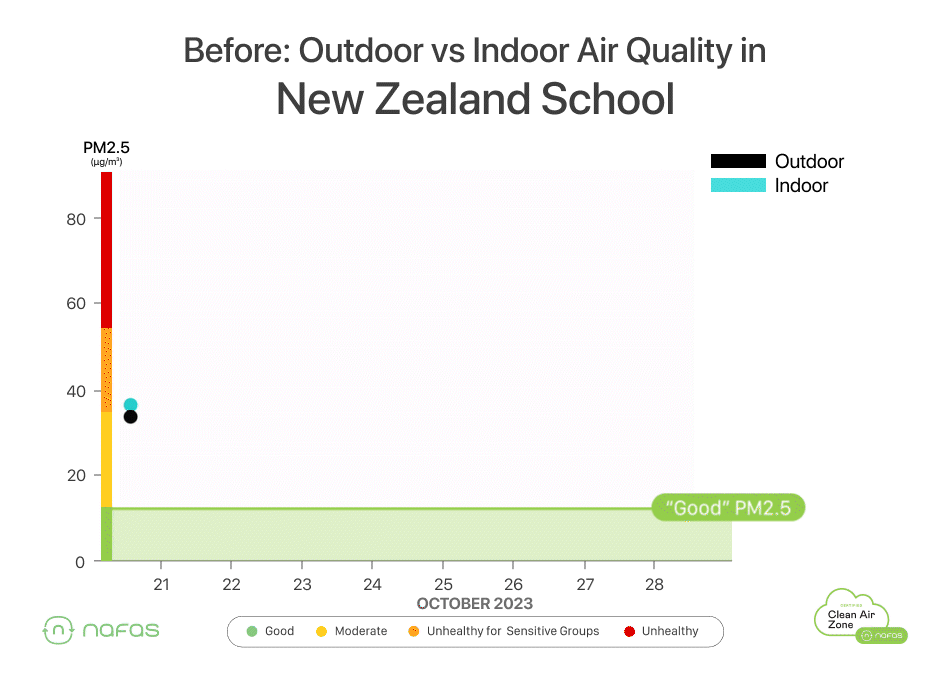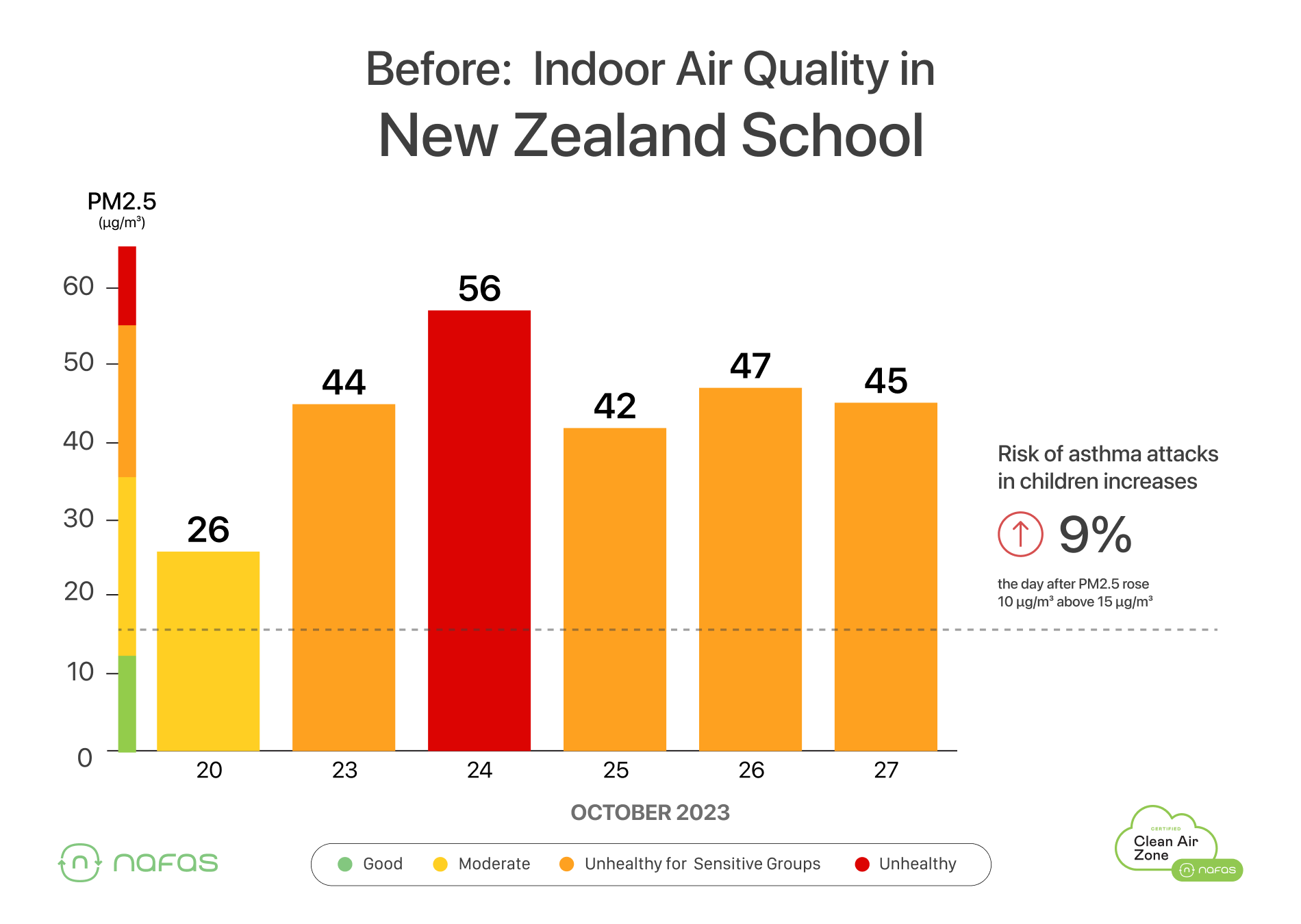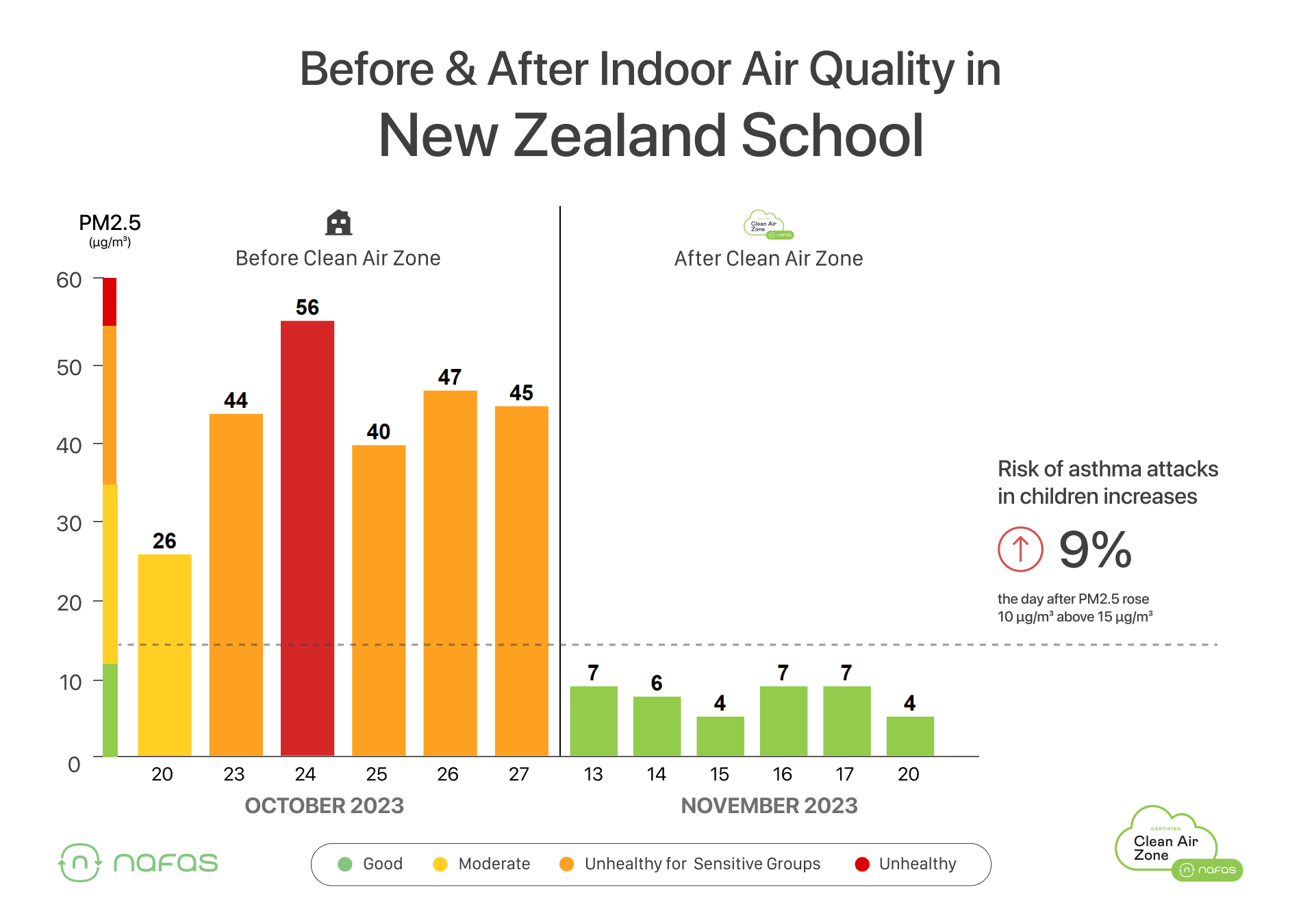LEARN / ARTICLE
CAZ Stories: Nafas Successfully Reduces Air Pollution at New Zealand School by 76%
CAZ Stories is a series of articles highlighting the significant impact of Clean Air Zones on diagnosing and improving indoor air quality issues for businesses in Indonesia. For more insights, read our previous case studies:
- AC Ventures
- Mighty Minds Preschool
- Global shipping company
- Mazars Indonesia
- IShine Kelapa Gading
- YCAB Foundation
Dealing with air pollution remains a persistent challenge, particularly in Jakarta. The recorded average PM2.5 level in DKI Jakarta in 2023 soared to 38 µg/m3, significantly surpassing the Indonesian National Ambient Air Quality Standard's annual average limit of 15 µg/m3—more than double. Notably, this figure is over seven times higher than the World Health Organization's (WHO) annual guideline.
The WHO has identified Particulate Matter 2.5 (PM2.5) as a critical health hazard due to its minuscule size and its ability to deeply penetrate our lungs. While PM2.5 poses a threat to the entire population, its risks are particularly severe for vulnerable groups, including children under five and adults over sixty.

Diagnostic tests conducted by the Nafas team indicate that the leakage level of PM2.5 pollution from outdoors into buildings is alarmingly high, reaching up to 100%. This is especially worrisome for those residing in areas with elevated pollution levels, such as Jakarta.
A recent article by Nafas, "Our Buildings Are Broken," highlights that PM2.5 pollution is not solely an outdoor concern but also an indoor one. In cities where outdoor pollution is high, there is no significant disparity between the air quality outdoors and indoors. Outdoor pollutants can compromise air quality within various indoor environments, including schools, where healthy air quality should not be optional—it should be the standard.
PM2.5 Pollution's Impact on Children's Health at School
A study featured in the Kosin Medical Journal, conducted by researchers from South Korea and Japan, delved into the short-term effects of PM2.5 on children. The findings revealed a concerning trend: the risk of asthma attacks in children increased by 9% when the concentration of PM2.5 rose by 10 μg/m³ from a baseline of 15 μg/m³ on the day preceding an asthma attack (Lee et al., 2018).
In response to these findings, Nafas has collaborated with New Zealand School Jakarta, concentrating on elevating indoor air quality across at school. Addressing this issue is crucial for establishing healthier school environments, benefiting not only students but also teachers and staff.
The Challenge: Compromised Air Quality Inside New Zealand School Jakarta
To evaluate the extent of outdoor pollution infiltrating the classrooms at New Zealand School Jakarta, Nafas deployed cloud-connected air quality monitors. These devices were tasked with monitoring PM2.5, CO2 levels, temperature, and humidity.
During our diagnostic phase, a noteworthy revelation came to light: the indoor and outdoor air quality closely mirrored each other. Analyzing data from October 2023, we observed that the trends of indoor (illustrated by the blue line) and outdoor (represented by the black line) air quality were nearly identical. Alarmingly, the air quality rarely fell below 15 μg/m³, the threshold for 'Good' air quality based on the study.

As revealed by our findings, indoor PM2.5 levels reached a peak of 56 µg/m³, nearly four times the recommended maximum of 15 µg/m³ as advised in scientific research. The current infrastructure of the school proved inadequate in filtering out external pollution. This underscores the imperative need to implement additional filtration measures at New Zealand School Jakarta to guarantee a healthier indoor environment.

Throughout the diagnostic period, Nafas translated the collected data into an AirScore. This AirScore offers a rating that mirrors the healthiness of the indoor air quality at the location.
The final AirScore for this school was a 'D', signifying that the indoor air quality was deemed unsafe and demanded substantial measures for improvement!
![]()
The Solution: Transforming New Zealand School Jakarta Into a Clean Air Zone
To tackle the challenge of poor indoor air quality in cities prone to pollution, such as Jakarta, Nafas has introduced the Clean Air Zones system. This comprehensive ecosystem is crafted to maintain healthy indoor air quality throughout operational hours. It accomplishes this through an integrated strategy that includes precise air quality measurement, effective purification techniques, robust certification standards, and engaging, data-driven programs for employees.
Our approach is both accessible and practical, featuring a no-initial-investment model complemented by a subscription-based service. This makes the enhancement of indoor air quality in schools straightforward and achievable.

Moreover, the system operates autonomously, eliminating the need for extra management effort or any initial financial investment!
The Result
In November 2023, New Zealand School Jakarta underwent a transformation into a Clean Air Zone. This transition facilitated a collaborative observation by Nafas and the school's management, highlighting a significant improvement in indoor air quality.

The Clean Air Zones at New Zealand School Jakarta successfully maintain the air quality inside all classrooms at a healthy level during school hours.

When contrasting the outdoor air quality with the indoor conditions, the remarkable improvement becomes strikingly evident. This proactive approach to reducing students' exposure to air pollution has notably elevated their AirScore from 'D' to 'A' at their school, while minimizing the health risk, notably asthma attack, on children.

The Monthly Report
Clean Air Zones are grounded in data-driven insights, with each location receiving reports monthly. These comprehensive reports spotlight the air quality conditions upheld by the Clean Air Zones. They also offer valuable data that schools can share with parents, teachers, staff, and shareholders, ensuring transparency and informed engagement. Below is a sample of the kind of report schools receive!

Becoming a Clean Air Zone is simple
Interested in ensuring your school's air quality is top-notch? Feel free to reach out to us at [email protected], or click the link below to register and work together with us to make clean air a standard in our schools!